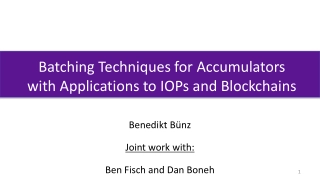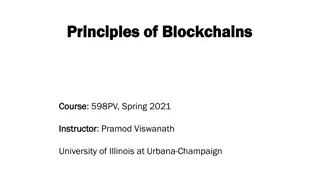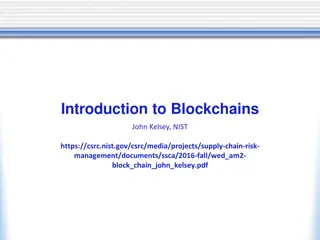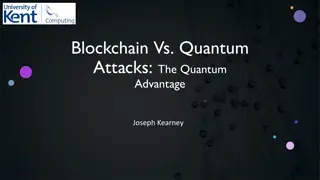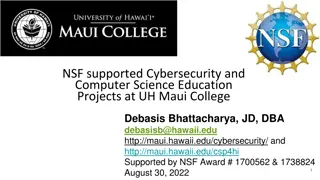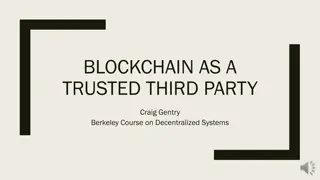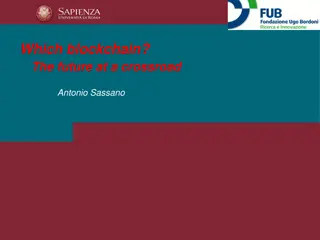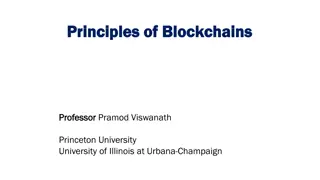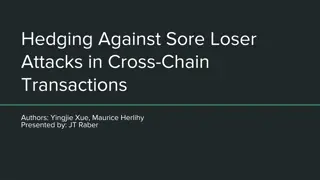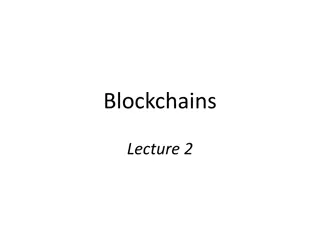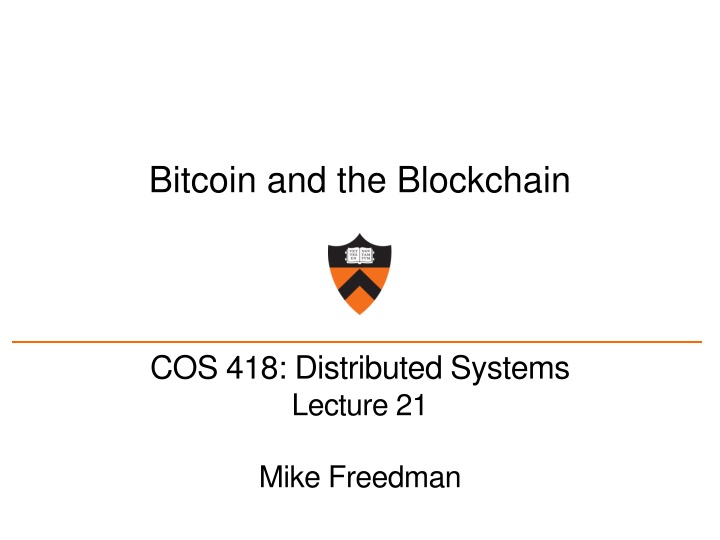
Bitcoin and Blockchain Technology in Distributed Systems
Delve into the world of Bitcoin and blockchain technology through a study of distributed systems. Explore the creation of new bitcoins, transactions, handling of double spending issues, traditional e-cash protocols, and the role of cryptography in ensuring security and integrity.
Download Presentation

Please find below an Image/Link to download the presentation.
The content on the website is provided AS IS for your information and personal use only. It may not be sold, licensed, or shared on other websites without obtaining consent from the author. If you encounter any issues during the download, it is possible that the publisher has removed the file from their server.
You are allowed to download the files provided on this website for personal or commercial use, subject to the condition that they are used lawfully. All files are the property of their respective owners.
The content on the website is provided AS IS for your information and personal use only. It may not be sold, licensed, or shared on other websites without obtaining consent from the author.
E N D
Presentation Transcript
Bitcoin and the Blockchain COS 418: Distributed Systems Lecture 21 Mike Freedman
Bitcoin: 10,000 foot view New bitcoins are created every ~10 min, owned by miner (more on this later) Thereafter, just keep record of transfers e.g., Alice pays Bob 1 BTC Basic protocol: Alice signs transaction: txn = SignAlice(BTC, PKBob) Alice shows transaction to others 2
Problem: Equivocation! Can Alice pay both Bob and Charlie with same bitcoin ? ( Known as double spending ) 3
How traditional e-cash handled problem Bank Alice Bob When Alice pays Bob with a coin, Bob validates that coin hasn t been spend with trusted third party Introduced blind signatures and zero-knowledge protocols so bank can t link withdrawals and deposits 4
How traditional e-cash handled problem Bank Alice Bob When Alice pays Bob with a coin, Bob validates that coin hasn t been spend with trusted third party Introduced blind signatures and zero-knowledge protocols so bank can t link withdrawals and deposits Bank maintains linearizable log of transactions 5
Problem: Equivocation! Goal: No double-spending in decentralized environment Approach: Make transaction log 1. public 2. append-only 3. strongly consistent 6
Bitcoin: 10,000 foot view Public Transactions are signed: txn = SignAlice (BTC, PKBob) All transactions are sent to all network participants No equivocation: Log append-only and consistent All transactions part of a hash chain Consensus on set/order of operations in hash chain 7
Cryptography Hash Functions Take message m of arbitrary length and produces fixed- size (short) number H(m) e.g., SHA-1 produces 160-bit output, SHA-256 has 256-bit output One-way function Efficient: Easy to compute H(m) Hiding property: Hard to find an m, given H(m) Collision resistance: Strong resistance: Find any m != m such that H(m) == H(m ) Given m, find m such that H(m) == H(m ) Weak resistance: 8
Blockchain: Append-only hash chain prev: H( ) prev: H( ) prev: H( ) txn 5 txn 6 txn 7 Hash chain creates tamper-evident log of txns Security based on collision-resistance of hash function Given m and h = hash(m), difficult to find m such that h = hash(m ) and m != m 10
Problem remains: forking prev: H( ) prev: H( ) prev: H( ) txn 5 txn 6 txn 7 prev: H( ) prev: H( ) txn 6 txn 7 12
Goal: Consensus Fault-tolerant protocols to achieve consensus of replicated log with malicious participants Requires: n >= 3f + 1 nodes, at most f faulty Problem Communication complexity is n2 Requires strongview of network participants 13
Consensus susceptible to Sybils Traditional consensus protocols based on membership assume independent failures which implies strong notion of identity Sybil attack (p2p literature ~2002) Idea: one entity can create many identities in system Typical defense: 1 IP address = 1 identity Problem: IP addresses aren t difficult / expensive to get, esp. in world of botnets & cloud services 14
Consensus based on work Rather than count IP addresses, bitcoin counts the amount of CPU time / electricity that is expended The system is secure as long as honest nodes collectively control more CPU power than any cooperating group of attacker nodes. - Satoshi Nakamoto Proof-of-work: Cryptographic proof that certain amount of CPU work was performed 15
Key idea: Chain length requires work prev: H( ) prev: H( ) prev: H( ) prev: H( ) prev: H( ) txn 8 txn 9 txn 5 txn 6 txn 7 prev: H( ) txn 6 Generating a new block requires proof of work Correct nodes accept longest chain Creating fork requires rate of malicious work >> rate of correct So, the older the block, the safer it is from being deleted 16
Use hashing to determine work! Recall hash functions are one-way / collision resistant Given h, hard to find m such that h = hash(m) But what about finding partial collision? m whose hash has most significant bit = 0? m whose hash has most significant bit = 00? Assuming output is randomly distributed, complexity grows exponentially with # bits to match 17
Bitcoin proof of work Find nonce such that hash (nonce || prev_hash || block data) < target i.e., hash has certain number of leading 0 s What about changes in total system hashing rate? Target is recalculated every 2 weeks Goal: One new block every 10 minutes 18
Historical hash rate trends of bitcoin Currently: 25 Exahash/s 25 x 1018 Tech: CPU GPU FPGA ASICs 19
Why consume all this energy? Creating a new block creates bitcoin! Initially 50 BTC, decreases over time, currently 3.125 Last halving on April 19, 2024 Block height is 840,281 as of 4-21-2024 New bitcoin assigned to party named in new block Called mining as you search for gold/coins 20
Bitcoin is worth (LOTS OF) money! 3.125 BTC = ~$202,800 today 21
Incentivizing correct behavior? Race to find nonce and claim block reward, at which time race starts again for next block hash (nonce || prev_hash || block data) As solution has prev_hash, corresponds to particular chain Correct behavior is to accept longest chain Length determined by aggregate work, not # blocks So miners incentivized only to work on longest chain, as otherwise solution not accepted Remember blocks on other forks still create bitcoin, but only matters if chain in collective conscious (majority) 22
Form of randomized leader election Each time a nonce is found: New leader elected for past epoch (~10 min) Leader elected randomly, probability of selection proportional to leader s % of global hashing power Leader decides which transactions comprise block 23
One block = many transactions Each miner picks a set of transactions for block Builds block header : prevhash, version, timestamp, txns, Until hash < target OR another node wins: Pick nonce for header, compute hash = SHA256(SHA256(header)) 24
Transactions are delayed At some time T, block header constructed Those transactions had been received [ T 10 min, T] Block will be generated at time T + 10 min (on average) So transactions are from 10 - 20 min before block creation Can be much longer if backlog of transactions are long 25
Commitments further delayed When do you trust a transaction? After we know it is stable on the hash chain Recall that the longer the chain, the hard to revert Common practice: transaction committed when 6 blocks deep i.e., Takes another ~1 hour for txn to become committed 26
Bitcoin & blockchain intrinsically linked security of block chain health of mining ecosystem value of currency 27
Summary Coins xfer/split between addresses (PK) in txns Blockchain: Global ordered, append-only log of txns Reached through decentralized consensus Each epoch, random node selected to batch transactions into block and append block to log Nodes incentivized to perform work and act correctly When solve block, get block rewards + txn fees Only keep reward if block persists on main chain 28
Appendix 29
Transaction format: strawman Create 12.5 coins, credit to Alice Transfer 3 coins from Alice to Bob SIGNED(Alice) Transfer 8 coins from Bob to Carol SIGNED(Bob) Transfer 1 coins from Carol to Alice SIGNED(Carol) How do you determine if Alice has balance? Scan backwards to time 0 ! 30
Transaction format 25.0 PK_Alice // Coinbase reward Inputs: Outputs: H(prevtxn, 0) 25.0 PK_Bob // 25 BTC from Alice Inputs: Outputs: SIGNED(Alice) H (prevtxn, 0) // 25 BTC From Alice 5.0 PK_Bob, 20.0 PK_Alice2SIGNED(Alice) H (prevtxn1, 1), H(prevtxn2, 0) // 10+5 BTC 14.9 PK_Bob Inputs: Outputs: Inputs: Outputs: SIGNED(Alice) Transaction typically has 1+ inputs, 1+ outputs Making change: 1st output payee, 2nd output self Output can appear in single later input (avoids scan back) 31
Transaction format 25.0 PK_Alice // Coinbase reward Inputs: Outputs: H(prevtxn, 0) 25.0 PK_Bob // 25 BTC from Alice Inputs: Outputs: SIGNED(Alice) H (prevtxn, 0) // 25 BTC From Alice 5.0 PK_Bob, 20.0 PK_Alice2SIGNED(Alice) H (prevtxn1, 1), H(prevtxn2, 0) // 10+5 BTC 14.9 PK_Bob Inputs: Outputs: Inputs: Outputs: SIGNED(Alice) Unspent portion of inputs is transaction fee to miner In fact, outputs are stack-based scripts 1 Block = 1MB max 32
Storage / verification efficiency Merkle tree Binary tree of hashes Root hash binds leaves given collision resistance Using a root hash Block header now constant size for hashing Can prune tree to reduce storage needs over time 33
Storage / verification efficiency Merkle tree Binary tree of hashes Root hash binds leaves given collision resistance Using a root hash Block header now constant size for hashing Can prune tree to reduce storage needs over time Can prune when all txn outputs are spent Now: 80GB pruned, 300GB unpruned 34
Bitcoin & blockchain intrinsically linked security of block chain health of mining ecosystem value of currency 35
Rich ecosystem: Mining pools health of mining ecosystem Mining == gambling: Electricity costs $, huge payout, low probability of winning Development of mining pools to amortize risk Pool computational resources, participants paid to mine e.g., rewards split as a fraction of work, etc Verification? Demonstrate easier proofs of work to admins Prevent theft? Block header (coinbase txn) given by pool 36


